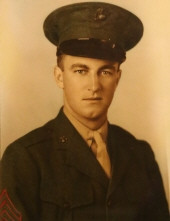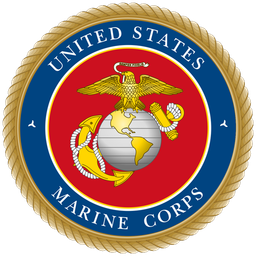

David H. Quinn
March 18, 1919 — November 20, 1943

David H. Quinn was born and raised in Temple, NH, the 4th of 9 children born to George Whitney & Kittie Evelyn (Edwards) Quinn. "3rd Generation Irish", David's father was also the 2nd Park Manager of Monadnock State Park and his mother worked at the park often as well. He enjoyed his times there immensely.
On May 24th of 1941, David enlisted in the United States Marine Corps Reserves. He was one of four Quinn brothers who served in World War II. He trained at Parris Island, SC, and Quantico, VA, prior to being sent to Dunedin, Florida, where he was assigned to a newly created amphibious tractor (“amtrac”) battalion. The amtracs, which are tracked vehicles, were designed for duty in the Pacific Theater of war and were capable of both open-water operation and climbing over coral reefs and land. Descendants of these early amtracs are still used extensively by the Marine Corps and are a vital part of all amphibious assaults.
Before leaving Florida, David was promoted to corporal and while in San Diego, in early 1942, was made Sergeant. He was promoted to 1st Sergeant at the age of 24. At San Diego, David was assigned to Company C, 2nd Amtrac Battalion, 2nd Marine Division. From San Diego, his unit was sent to New Zealand for extensive training in amphibious assaults. While stationed in New Zealand, he met Zoe Boeson, who was in training to become a nurse. David and Zoe were married on June 28, 1943 and were together for four months before David shipped out. Years later, Zoe said that they found more happiness in those four months than many people find in a lifetime.
1st Sgt. Quinn was with his brothers in Company C, 2nd Amphibious Tractor Battalion of the 2nd Marine Division when they landed on Betio, which was part of Operation Galvanic. Betio is one of several islands in the Tarawa Atoll, which is part of the Gilbert Islands. The goal was to capture the island to gain control its airstrip on Betio. The airstrip was absolutely critical to the U.S. forces’ island-hopping campaign, the goal of which was to eventually assault Japanese mainland itself.
Betio was also of immense importance to the Japanese, who used it as a base for attacking U.S. forces in the Central Pacific. Because of its critical importance, the Japanese had spent 20 months building fortifications on the island, including artillery installations and hundreds of concrete machine gun pillboxes, and five-foot thick concrete enclosures. The Japanese commander boasted that a million men could not capture Betio in a hundred years. The Marines got the job done in 76 hours, but the cost was high. The number of Marines killed was 1029, with approximately 2700 additional men wounded. The Japanese garrison contained approximately 4500 soldiers, all but 17 of whom were killed. To this day, the Marines refer to the battle as “bloody Tarawa.”
1st Sgt. Quinn died on November 20th, 1943, when he was mortally wounded by an exploding enemy shell during the first wave of the assault. Buried on Tarawa, the identity of David’s remains was lost, and he subsequently became one of many “unknowns.” Eventually, his unidentified remains were disinterred and reburied at The Cemetery of the Pacific (“Punchbowl”) in Honolulu, Hawaii. In October 2016, Quinn was disinterred, and a DNA sample taken and recorded. His DNA was later compared to DNA samples submitted by two of his nieces, and a positive match was made, thereby changing his status from unknown to “accounted for.”
1st Sgt. Quinn will finally be reunited with his family on Friday, May 4th, 2018, 75 years after his death. He will be remembered and honored on Saturday, May 5, at 11:00 am, with a funeral service in the Congregational Church of Temple, 17 Main Street, Temple, NH 03084. Burial will follow with full Military Honors in Miller Cemetery.
Memorial donations may be made to the Wounded Warrior Project in his name at www.woundedwarriorproject.org
Service Schedule
Past Services
Funeral Service
Saturday, May 5, 2018
Starts at 11:00 am (Eastern time)
Congregational Church of Temple
Guestbook
Visits: 16
This site is protected by reCAPTCHA and the
Google Privacy Policy and Terms of Service apply.
Service map data © OpenStreetMap contributors



